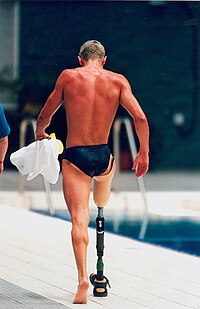
Photo from wikipedia
Selecting an optimal prosthetic foot is particularly challenging for highly active individuals with limb loss, such as military personnel, who need to seamlessly perform a variety of demanding activities/tasks (often… Click to show full abstract
Selecting an optimal prosthetic foot is particularly challenging for highly active individuals with limb loss, such as military personnel, who need to seamlessly perform a variety of demanding activities/tasks (often with and without external loads) while minimizing risk of musculoskeletal injuries over the longer term. Here, we expand on prior work by comparing biomechanical and functional outcomes in two prosthetic feet with the largest differences in mechanical response to added load (i.e., consistently "Compliant" and "Stiff" forefoot properties). In each foot, fourteen male Servicemembers with unilateral transtibial limb loss (from trauma) completed instrumented gait analyses in all combinations of two loading conditions (with and without 22 kg weighted vest) and two walking speeds (1.34 and 1.52 m/s), as well as the Prosthesis Evaluation Questionnaire. With the Stiff foot, sound limb peak loading was 2% smaller (p = 0.043) in the loaded versus unloaded condition, but similar between loading conditions in the Compliant foot (note, the Stiff foot was associated with larger loads, overall). Independent of load or walking speed, the Compliant (versus Stiff) foot provided 67.9% larger (p < 0.001) prosthetic push-off, 17.7% larger (p = 0.01) roll-over shape radii, and was subjectively favored by 10 participants. A more Compliant versus Stiff prosthetic foot therefore appears to better accommodate walking with and without added load, and reinforce the notion that mechanical properties of prosthetic feet should be considered for near-term performance and longer-term (joint) health.
Journal Title: Journal of biomechanics
Year Published: 2019
Link to full text (if available)
Share on Social Media: Sign Up to like & get
recommendations!